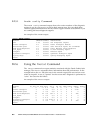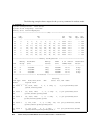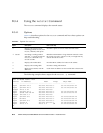
B-18 SPARC Enterprise M4000/M5000 Servers Installation Guide • December 2010
The following example shows output for the ping -s command.
B.3.6 Using the ps Command
The ps command lists the status of processes. Using options and rearranging the
command output can assist in determining the resource allocation.
B.3.6.1 Options
TABLE B-8 describes options for the ps command and how those options can help
troubleshooting.
The following example shows output for one ps command.
# ping -s san-ff2-17-a
PING san-ff2-17-a: 56 data bytes
64 bytes from san-ff2-17-a (10.1.67.31): icmp_seq=0. time=0.427 ms
64 bytes from san-ff2-17-a (10.1.67.31): icmp_seq=1. time=0.194 ms
^C
----san-ff2-17-a PING Statistics----
2 packets transmitted, 2 packets received, 0% packet loss
round-trip (ms) min/avg/max/stddev = 0.172/0.256/0.427/0.102
#
TABLE B-8 Options for ps
Option Description How It Can Help
-e Displays information for every
process.
Identifies the process ID and the executable.
-f Generates a full listing. Provides the following process information: user ID,
parent process ID, time when executed, and the path to
the executable.
-o option Enables configurable output.
The
pid, pcpu, pmem, and
comm options display process
ID, percent CPU consumption,
percent memory consumption,
and the responsible executable,
respectively.
Provides only most important information. Knowing the
percentage of resource consumption helps identify
processes that are affecting performance and might be
hung.


















